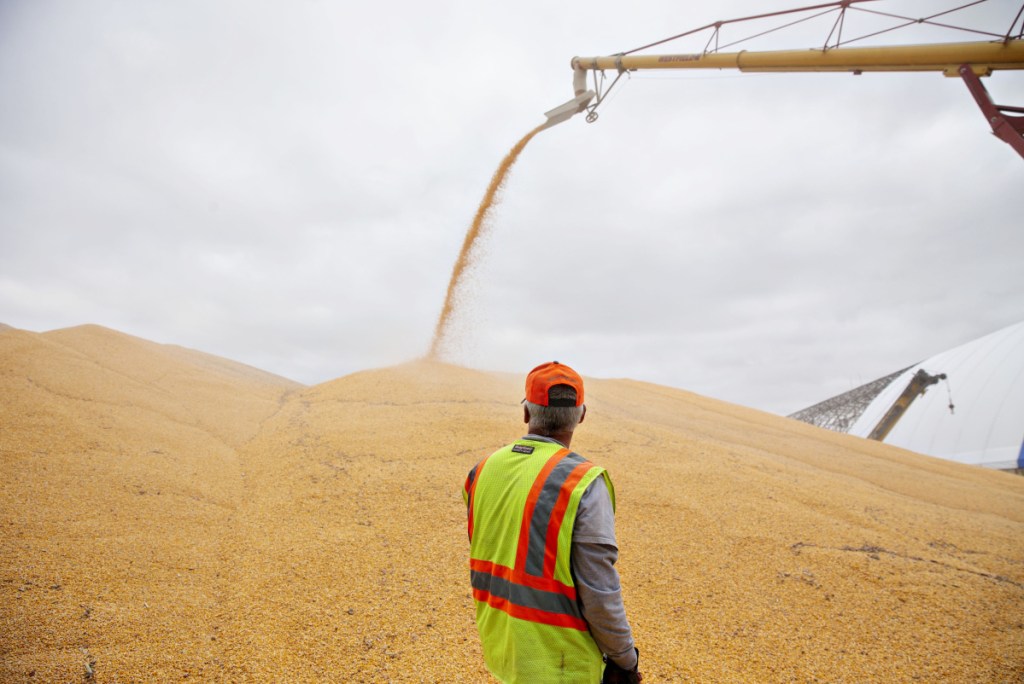Things are not looking good for the U.S. farm economy.
On Thursday, the farm belt’s malaise deepened after the U.S. Department of Agriculture predicted soybean exports would stay below their pre-trade war levels until the 2026-2027 season. That followed a report that sales of the oilseed in early January had the worst week ever. And things didn’t end there: The Federal Reserve Bank of Kansas City warned that farm incomes were likely to have a weak start in 2019 and that credit was tightening at lenders.
“It’s not a pretty picture, but it’s not getting a lot worse quickly,” said Dan Kowalski, at farm lender CoBank Acb in Greenwood Village, Colorado. “It’s getting modestly worse over time.”
Some of the hurdles have been around for years. Consecutive seasons of bumper crops kept grain inventories flush. At the same time, U.S. meat production was soaring and dairies were overflowing. The supply boom meant prices stayed low for a long time, while robust demand kept things from falling off a cliff. In fact, farm income posted a 22 percent rebound in 2017.
Then came Donald Trump’s trade war.
As tensions escalated between Beijing and Washington, China slapped tariffs on a host of U.S. agricultural goods. Soybeans grabbed most of the headlines, though a myriad of other products are facing duties. Apricots, alfalfa, cherries, pistachios, pork and sorghum are some of the items on the hit list.
Ethanol, made from corn, has also felt the blow. Todd Becker, chief executive officer of biofuel maker Green Plains Inc., said Monday that the industry, collectively, may have burned through about $1 billion in cash to weather the tough 2018. China has 70 percent tariffs on the U.S. fuel additive.
Farmers are part of the base that helped drive Trump’s election victory. Amid the economic woes, support for the president has mostly stayed resilient. Still, there are some cracks starting to show. At an ethanol conference last month in Iowa, Jeff Altena, a farmer and a director of operations at Siouxland Energy Cooperative, said the “long rope” the agriculture community gave the administration may be starting to fray.
To becalm his constituency, Trump has tweeted about his “love” for farmers. When he addressed the American Farm Bureau in January, his speech drew applause and cheers as he lobbied for a border wall, while telling the audience that he’ll make it “easier” for migrants to work on farms.
His administration delivered an aid package to help counter the blow from tariffs. Growers had until Thursday to sign up for the so-called Market Facilitation Program. More than 864,000 producers applied since the program’s debut in September, and payments have reached almost $8 billion, the USDA said this week.
“The bailouts did help out some,” Lynn Rohrscheib, chairwoman of the Illinois Soybean Association, said in an interview with Bloomberg Television this week. “But most farmers, they just didn’t want that. We want to be able to grow our crop and receive a fair price.”
LOSING OUT ON KEY RELATIONSHIPS
Rohrscheib said she knows of some producers who aren’t farming this year because of the tariffs, and that her family “took a $600,000 hit to our annual income” as a result of the trade war.
While a truce in the trade war brought China back to the U.S. soybean market, purchases have been too small to make up for shrinking shipments. Inventories are still bulging across the Midwest, and prices are down 11 percent in the past 12 months.
The U.S. and China reportedly “made headway” during trade talks this week in Beijing, but there’s still much work to be done before Trump and his counterpart Xi Jinping look to seal a deal at a yet-to-be scheduled summit, people familiar with discussions said. USDA Deputy Secretary Steve Censky said on Wednesday that agriculture issues remain unresolved.
“We’re still very much in the discussion and negotiating stage,” Censky said on the sidelines of an ethanol conference in Orlando, Florida. “The Chinese have to be, in our view, a lot more forthcoming than what they have been to date.”
Even if a deal is reached, it could be years before the farm economy completely bounces back. When importers shift to new suppliers, the U.S. loses out on the relationships it built, while rivals are able to strengthen their ties.
EMPLOYERS FORCED TO BOOST WAGES
Meanwhile, other Trump policies have also taken a bite of out of the farm economy.
A labor shortage , which some in the industry say is at least partly sparked by Trump’s tough stand on immigration, means employers have been forced to boost wages in the face of sluggish markets. On Thursday, U.S. poultry producer Pilgrim’s Pride Corp. said it was increasing wages $50 million, year over year, to attract workers.
“A tight labor market in the U.S. and difficult market conditions last year are likely to weigh on at least some of the expansion plans” for the poultry industry, Pilgrim’s Chief Executive Officer Bill Lovette said Thursday on a conference call. The company is “trying to develop some proprietary automation to do some of the more difficult tasks in our plants to alleviate that pressure on labor,” he said.
“I think every company is facing virtually that same pressure.”
Send questions/comments to the editors.



Success. Please wait for the page to reload. If the page does not reload within 5 seconds, please refresh the page.
Enter your email and password to access comments.
Hi, to comment on stories you must . This profile is in addition to your subscription and website login.
Already have a commenting profile? .
Invalid username/password.
Please check your email to confirm and complete your registration.
Only subscribers are eligible to post comments. Please subscribe or login first for digital access. Here’s why.
Use the form below to reset your password. When you've submitted your account email, we will send an email with a reset code.